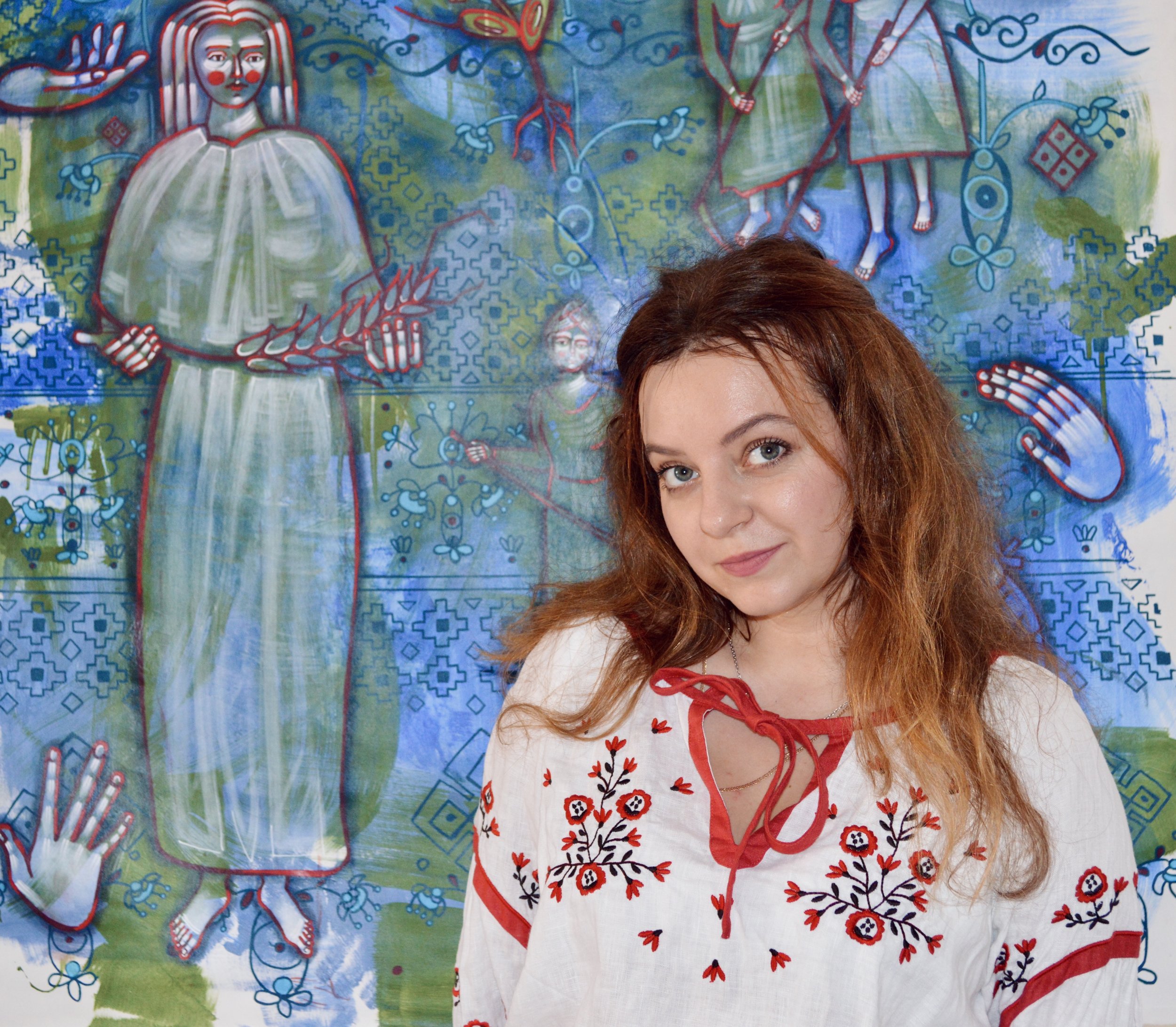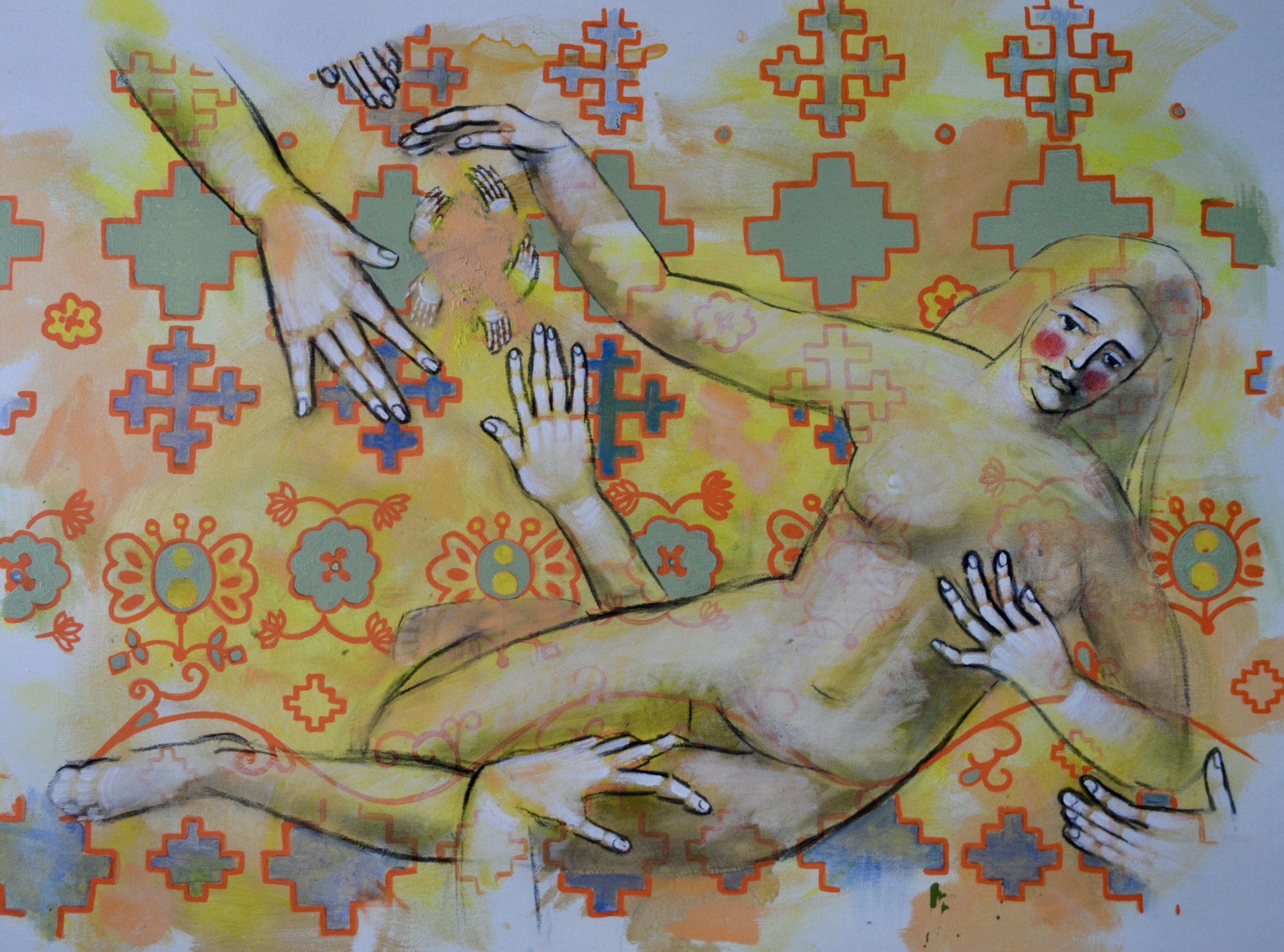10 Questions with Yuliia Chaika
Yuliia Chaika was born in Kyiv, Ukraine, and as an artist, she fully found herself and her style in Spain.
In Ukraine, she received a professional education at the Kyiv State Academy of Decorative Art and Design, named after M. Boychuk, and gained experience working in a workshop as a master of icon painting. This allowed her to become deeply familiar with the intricacies of Byzantine art, a fact that has significantly influenced her artistic journey.
Yuliia Chaika - Portrait
ARTIST STATEMENT
Yuliia Chaika draws inspiration from the folk art of Ukraine. Living far from her homeland, she has been fascinated by the study of Ukrainian history, traditions, and way of life. This is why she incorporates Ukrainian ornaments as a background in her paintings. She creates the image of the earth using the colors of clay and the texture of dirt. For her, the background is like a field, which she sows with ornaments once used to decorate clothing, household items, and homes in ancient Ukraine. These elements allow her to touch history and bring it into the present.
In most of her works, the main theme is devoted to women. Through the female image, she expresses her emotions and concerns, offering a personal lens through which she views the world.
Her works are dominated by green, brown, blue, and red palettes. The physicality of the painting is enhanced by the accentuation of red. Even though the figures in her paintings are clearly outlined, they appear to emerge through the canvas of the ornament, creating the magical effect of an ancient fresco that has survived through the centuries.
The symbol of touch, which is a recurring element in her works, serves as a powerful tool for the creator. It also reflects an emotional state that conveys more about a person than facial expressions. Touch acts as a mediator for transferring both spiritual and physical energy. Hands, for her, represent a distinct human narrative that sparks her artistic curiosity.
Her creative method, which includes building composition and techniques drawn from Byzantine art, gives her works the appearance of sacred paintings.
THE FOREST SONG, sanguine and acrylic on canvas, 116x90 cm, 2023 © Yuliia Chaika
INTERVIEW
First of all, introduce yourself to our public. Who are you, and how did you develop into the artist you are today?
My artistic journey began in Ukraine, where I was deeply influenced by the rich traditions of folk art and Byzantine motifs. However, it was Spain that gave me the space to find my own voice. Over time, I have woven these two worlds together—my work now reflects the marks of my heritage while also being shaped by the new perspectives I discovered while living far from home. I work at the intersection of contemporary folk art, naïve style, symbolism, and abstraction. I am Yuliia Chaika. Pleased to meet you.
You received professional training in Ukraine and later found your artistic voice in Spain. How did both of these places shape your work and style?
Ukraine grounded me in tradition. From the precise discipline of icon painting to the deep symbolism of folk art, I learned to honor the past. Spain, on the other hand, pushed me to break boundaries. Its vibrant art scene encouraged me to experiment, to blend the old with the new. Together, these two places form the backbone of my style—where the earthiness of Ukrainian history meets the bold freedom of contemporary expression.
IN THE APPLE ORCHARD, acrylic and sanguine on canvas, 60x60 cm, 2023 © Yuliia Chaika
THE HOTTEST MONTH OF THE YEAR. HARVEST, acrylic on canvas, 100x100 cm, 2023 © Yuliia Chaika
What do you wish you knew about contemporary art and the art world before you got started?
Before I started, I wish I had understood the complexity of the art world and how to navigate it. It’s important to be aware of not only the creative process but also the business and networking aspects of being an artist.
Your work incorporates Ukrainian folk art and traditions. What draws you to these cultural elements, and how do you incorporate them into your paintings?
Ukrainian history, traditions, and folk art are a profound source of inspiration for me. In my work, I use Ukrainian ornaments as a backdrop, symbolizing a deep connection to the earth and our cultural heritage. I envision myself sowing a field where each ornament is like a seed from which the world I create begins to grow.
The theme of women is central to your work. What inspired you to focus on female figures, and how do they help you express your emotions and concerns?
The female form is more expressive and fragile to me. While it is more difficult to depict, but it is easier for the audience to understand. Through this form, I can express a broader spectrum of emotions because I connect with them more deeply.The process of transferring my thoughts into this form serves as a form of therapy for me.
YELLOW ILLUSION, acrylic and charcoal on canvas, 54x73 cm, 2024 © Yuliia Chaika
You have a peculiar color palette that primarily includes earth tones. How do you choose your colors? And how do these colors contribute to the themes and emotions you want to convey in your art?
My palette is dominated by earth and clay colors -green, brown, blue, grey, red, and white. I use them to evoke feelings of grounding and confidence. It reflects my connection to nature. I enhance the figures with red to accentuate the architecture of movement within the composition, adding greater expressive power.
Can you describe your creative process when working on a new piece?
I begin my work by meticulously researching the theme I want to explore. I search for outlines of figures and the necessary ornamental elements. It often takes numerous sketches to create a single piece. I start by crafting the background, mimicking the texture of the earth—its cracks and irregularities. Then, I paint the image , followed by the addition of ornamental details and white highlights to complete the composition.
You’ve drawn inspiration from Byzantine art, especially in composition and technique. How do you blend these ancient influences with contemporary themes in your work?
Byzantine art, particularly its iconography and symbolism, inspires the sacred and spiritual aspects of my work. I mix these elements with contemporary themes like personal identity and the female experience, creating a balance between the historical and the modern. In my works, the symbol of touch and connection — the hand — plays also a central role. In iconography, this, too, is a highly emphasized element, carrying diverse symbolic meanings. It can represent both an appeal to higher powers and the manifestation of personal will, as well as the ability to make compromises. A person with hands lowered is often seen as someone incapable of action.
SHADOWS OF FORGOTTEN ANCESTORS, sanguine, thread, acrylic on canvas, 130x90 cm, 2023 © Yuliia Chaika
What new projects or themes are you excited to explore in the future, and how do you see your work evolving?
I am excited to explore more abstract forms and continue blending traditional Ukrainian motifs with global influences. I also want to experiment further with mixed media, try my hand at clay sculpting, and create larger installations that immerse viewers in my world of cultural narratives. In the future, I plan to paint murals for interiors or even, if the opportunity arises, to make murals for a church.
Lastly, what is your biggest goal for this year?
My biggest goal this year is to expand my audience and showcase my work internationally, connecting with people who resonate with the themes of identity, history, and culture that I explore in my art.
Artist’s Talk
Al-Tiba9 Interviews is a promotional platform for artists to articulate their vision and engage them with our diverse readership through a published art dialogue. The artists are interviewed by Mohamed Benhadj, the founder & curator of Al-Tiba9, to highlight their artistic careers and introduce them to the international contemporary art scene across our vast network of museums, galleries, art professionals, art dealers, collectors, and art lovers across the globe.




















